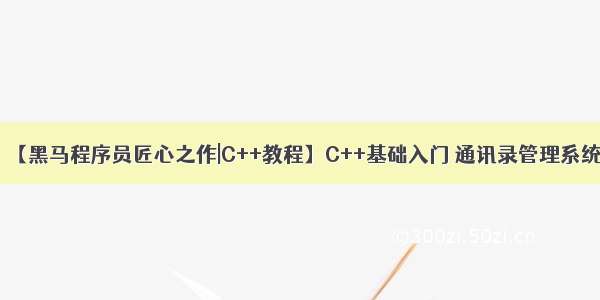
黑马程序员匠心之作|C++教程从0到1入门编程
关于P64~P71-练习-结构体
1、结构体的定义和使用2、结构体数组3、结构体指针4、结构体嵌套结构体5、结构体做函数参数6、结构体中const使用场景7、结构体案例1-毕业设计8、结构体案例2-英雄排名1、结构体的定义和使用
结构体属于用户自定义的数据类型,允许用户存储不同的数据类型。
语法:struct 结构体名 {结构体成员列表};
通过结构体创建变量的方式有3种:
1、struct 结构体名 变量名
2、struct 结构体名 变量名={成员1值,成员2值……}
3、定义结构体时顺便创建变量
#include<iostream>#include<string>using namespace std;//1、创建学生数据类型:学生包括(姓名,年龄,分数)//自定义数据类型,一些类型集合组成的一个类型//语法 struct 类型名称 { 成员列表 }struct Student{//成员列表//姓名string name;//年龄int age;//分数int score;}s3;//2.3 定义结构体时顺便创建变量//2、通过学生类型创建具体学生int main(){//2.1 struct Student s1//struct关键字可以省略//struct Student s1;Student s1;//给s1属性赋值,通过.访问结构体变量中的属性s1.name = "张三";s1.age = 18;s1.score = 100;cout << "姓名:" << s1.name << "年纪:" << s1.age << "成绩:" << s1.score << endl;//2.2 struct Student s2 ={……}struct Student s2 = { "李四", 19 , 80 };cout << "姓名:" << s2.name << "年纪:" << s2.age << "成绩:" << s2.score << endl;//2.3 定义结构体时顺便创建变量s3.name = "王五";s3.age = 20;s3.score = 70;cout << "姓名:" << s3.name << "年纪:" << s3.age << "成绩:" << s3.score << endl;system("pause");return 0;}
问题:cout下面多了红色波浪线
解决方法:把前面的命名空间注释掉,如:
#include< iostream>
//using namespace std;
然后再改回去:
#include< iostream>
using namespace std;
奇奇怪怪的就好了,但是不晓得原因。。。
2、结构体数组
将自定义的结构体放入数组中方便维护。
语法:struct 结构体名 数组名[元素个数]={{},{},……{}}
#include<iostream>#include<string>using namespace std;//结构体数组//1、定义结构体struct Student{//成员列表//姓名string name;//年龄int age;//分数int score;};int main(){//2、创建结构体数组struct Student stuArray[3]={{"张三",19,100},{"李四",18,80},{"王五",20,90}};//3、给结构体数组中的元素赋值stuArray[2].name = "赵六";stuArray[2].age = 30;stuArray[2].score = 95;//4、遍历结构体数组for (int i = 0;i < 3;i++){cout << "姓名:" << stuArray[i].name <<" "<< "年龄:" << stuArray[i].age << " "<< "成绩:" << stuArray[i].score << " " << endl;}system("pause");return 0;}
3、结构体指针
通过指针访问结构体中成员
利用操作符->可以通过结构体指针访问结构体属性
#include<iostream>#include<string>using namespace std;//结构体指针//定义学生的结构体struct Student{string name; //姓名int age; //年龄int score; //分数};int main(){//1、创建学生结构体变量struct Student s = { "张三",18,100 };//2、通过指针指向结构体变量struct Student * p = &s;//3、通过指针访问结构体变量中的数据//利用操作符->可以通过结构体指针访问结构体属性cout << "姓名:" << p->name << " "<< "年龄:" << p->age << " "<< "成绩:" << p->score << " " << endl;system("pause");return 0;}
4、结构体嵌套结构体
例如:每个老师辅导一个学员,一个老师的结构体中,记录一个学生的结构体。
#include<iostream>#include<string>using namespace std;//结构体嵌套结构体//定义学生的结构体struct student{string name; //姓名int age; //年龄int score; //分数};// 定义老师的结构体struct teacher{int id; //教师编号string name; //教师姓名int age; //年龄struct student stu;//辅导的学生};int main(){//创建老师struct teacher t = { 1,"张老师",40,{"张三",18,100} };/*struct teacher t;t.id = 10000;t.name = "老王";t.age = 40;t.stu.name = "小王";t.stu.age = 19;t.stu.score = 100;*/cout << "老师姓名:" << t.name << endl<< "老师id:" << t.id << endl<< "老师年龄:" << t.age << endl<< "老师辅导的学生姓名:" << t.stu.name << endl<< "老师辅导的学生年龄:" << t.stu.age << endl<< "老师辅导的学生成绩:" << t.stu.score << endl;system("pause");return 0;}
5、结构体做函数参数
结构体作为参数向函数中传递,传递方式有两种:
1、值传递-形参变,实参不变
2、地址传递-形参变,实参变
#include<iostream>#include<string>using namespace std;//结构体做函数的参数//将学生传入到一个参数中,打印学生身上的所有信息//定义学生的结构体struct Student{string name; //姓名int age; //年龄int score; //分数};//打印学生信息函数//1、值传递void printStudent1(struct Student s){s.age = 100;cout << "printstudent1中打印结果:" << endl<< "学生姓名:" << s.name << endl<< "学生年龄:" << s.age << endl<< "学生成绩:" << s.score << endl;}//2、地址传递void printStudent2(struct Student *p){p->age = 200;cout << "printstudent2中打印结果:" << endl<< "学生姓名:" << p->name << endl<< "学生年龄:" << p->age << endl<< "学生成绩:" << p->score << endl;}int main(){struct Student s;s.name = "张三";s.age = 18;s.score = 100;printStudent1(s);cout << "main中打印结果:" << endl<< "学生姓名:" << s.name << endl<< "学生年龄:" << s.age << endl<< "学生成绩:" << s.score << endl;//struct student *p = &s;printStudent2(&s);cout << "main中打印结果:" << endl<< "学生姓名:" << s.name << endl<< "学生年龄:" << s.age << endl<< "学生成绩:" << s.score << endl;system("pause");return 0;}
问题:
使用了未定义类型“Student”
note: 参见“Student”的声明
“.age”的左边必须有类/结构/联合
解决方法:将定义的结构体放到定义的函数之前
6、结构体中const使用场景
作用:用const防止误操作。
#include<iostream>#include<string>using namespace std;//结构体中const使用场景//定义学生的结构体struct Student{string name; //姓名int age; //年龄int score; //分数};//打印学生信息函数//将函数中的形参改为指针,可以减少内存空间,而且不会复制新的副本出来void printStudent(const struct Student *s){//s->age = 100;//加入const之后,一旦有修改操作就会报错,可以防止我们误操作cout << "printstudent1中打印结果:" << endl<< "学生姓名:" << s->name << endl<< "学生年龄:" << s->age << endl<< "学生成绩:" << s->score << endl;}int main(){struct Student s;s.name = "张三";s.age = 18;s.score = 100;//通过函数打印结构体变量信息printStudent(&s);cout << "main中打印结果:" << endl<< "学生年龄:" << s.age << endl;system("pause");return 0;}
7、结构体案例1-毕业设计
案例描述:学校正在做毕设项目,每名老师带领5个学生,总共有3名老师,需求如下:
1、设计学生和老师的结构体,其中在老师的结构体中,有老师姓名和一个存放5名学生的数组作为成员,学生成员有姓名,考试分数
2、创建数组存放3名老师
3、通过函数给每个老师及所带的学生赋值
4、最终打印出老师数据以及老师所带的学生数据
#include<iostream>#include<string>#include<ctime>using namespace std;//1、设计学生和老师的结构体//其中在老师的结构体中,有老师姓名和一个存放5名学生的数组作为成员//学生成员有姓名,考试分数//定义学生结构体struct student{//姓名string sName;//成绩int score;};//定义老师结构体struct teacher{//姓名string tName;//学生数组struct student sArry[5];};//给老师和学生赋值函数void allocateSpace(struct teacher tArry[],int len){string nameSeed = "ABCDE";//给老师赋值for (int i = 0;i < len;i++){tArry[i].tName = "Teacher_";tArry[i].tName += nameSeed[i];//通过循环给每名老师所带学生赋值int len1 = sizeof(tArry[i].sArry) / sizeof(tArry[i].sArry[0]);for (int j = 0;j < len1;j++){tArry[i].sArry[j].sName = "Student_";tArry[i].sArry[j].sName += nameSeed[j];//需要加随机数种子int random = rand() % 61 + 40;//0+40~60+40tArry[i].sArry[j].score = random;}}}//打印出老师数据以及老师所带的学生数据函数void printInfo(struct teacher tArry[], int len){for (int i = 0;i < len;i++){cout << "老师姓名:" << tArry[i].tName << endl;cout << "该老师所带学生信息:" << endl;int len1 = sizeof(tArry[i].sArry) / sizeof(tArry[i].sArry[0]);for (int j = 0;j < len1;j++){cout << "\t学生姓名:" << tArry[i].sArry[j].sName << " "<< "学生成绩:" << tArry[i].sArry[j].score << endl;}}}int main(){//随机数种子srand((unsigned int)time(NULL));//加#include<ctime>//2、创建数组存放3名老师struct teacher tArry[3] = {};//3、通过函数给每个老师及所带的学生赋值int len = sizeof(tArry) / sizeof(tArry[0]);allocateSpace(tArry,len);//4、最终打印出老师数据以及老师所带的学生数据printInfo(tArry, len);system("pause");return 0;}
注意:
1、\t的使用
2、随机数种子的使用
#include<ctime>srand((unsigned int)time(NULL));int random = rand() % 61 + 40;
3、命名的小窍门
string nameSeed = "ABCDE";for (int i = 0;i < len;i++){tArry[i].tName = "Teacher_";tArry[i].tName += nameSeed[i];}
8、结构体案例2-英雄排名
案例描述:
设计一个英雄的结构体,包括成员姓名、年龄、性别;创建结构体数组,数组中存放5名英雄。通过冒泡排序算法,将数组中的英雄按照年龄进行升序排序,最终打印排序后的结果。
5名英雄信息如下:
{ "刘备",23,"男" },{ "关羽",22,"男" },{ "张飞",20,"男" },{ "赵云",21,"男" },{ "貂蝉",19,"女" }
#include<iostream>#include<string>using namespace std;//1、设计一个英雄的结构体,包括成员姓名、年龄、性别struct hero{string name;int age;string sex;};//冒泡排序,年龄升序void bubbleSort(struct hero arry[], int len){for (int i = 0;i < len - 1;i++){for (int j = 0;j < len - i - 1;j++){if (arry[j].age > arry[j + 1].age){struct hero temp = arry[j];arry[j] = arry[j + 1];arry[j + 1] = temp;}}}}//最终打印排序后的结果函数void printHero(struct hero arry[], int len) {for (int i = 0;i < len;i++){cout << "姓名:" << arry[i].name<< " 年龄:" << arry[i].age<< " 性别:" << arry[i].sex << endl;}}int main(){//2、创建结构体数组,数组中存放5名英雄struct hero arry[5]={{ "刘备",23,"男" },{ "关羽",22,"男" },{ "张飞",20,"男" },{ "赵云",21,"男" },{ "貂蝉",19,"女" }};int len = sizeof(arry) / sizeof(arry[0]);//3、通过冒泡排序算法,将数组中的英雄按照年龄进行升序排序cout << "排序前打印结果:" << endl;for (int i = 0;i < len;i++){cout << "姓名:" << arry[i].name<< " 年龄:" << arry[i].age<< " 性别:" << arry[i].sex << endl;}bubbleSort(arry, len);//4、最终打印排序后的结果。cout << "排序后打印结果:" << endl;printHero(arry, len);system("pause");return 0;}
注意:冒泡排序中定义的temp是英雄的结构体,交换的值也是英雄的结构体
(测试过程中未考虑到这点,将英雄的年龄换了。。。)
















